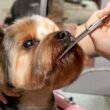To get a dog not to move while grooming, train them to stay still on command. Then, use positive reinforcement to reward good behavior during grooming sessions.
Touch and handle your dog’s body to desensitize them to the grooming process. Grooming your furry friend is necessary for their well-being, but it can be challenging if they won’t stay still. If you’re struggling to groom your dog without them squirming or moving around, don’t worry – it’s a common problem.
Luckily, there are several techniques you can use to keep your pup in place. In this article, we’ll explore some tips and tricks for getting your dog to stay calm and collected during grooming sessions. Keep reading to learn how to groom your furry friend like a pro!

Understanding The Importance Of Proper Dog Grooming
Grooming is not just about your furry companion looking and smelling good, but also about keeping them healthy and happy. Here are some key points to help you understand the importance of proper dog grooming.
The Physical And Emotional Benefits Of Grooming For Dogs
Grooming has numerous benefits for your dog’s physical and emotional well-being such as:
- Regular grooming can help maintain healthy skin and a well-conditioned coat.
- It promotes good blood circulation and stimulates natural oil production in their skin.
- It reduces the risk of skin irritations and infections.
- It can alleviate stress and anxiety in dogs.
The Negative Effects Of A Poorly-Groomed Dog
Neglecting grooming can have harmful consequences for your dog, some of which are:
- It can cause skin infections, matting, and hair loss.
- Dead hair, dirt, and debris can accumulate on their skin, leading to a breeding ground for fleas, ticks, and other parasites.
- It increases the risk of painful and costly medical conditions.
The Importance Of Making Grooming A Positive Experience For Your Dog
For most dogs, grooming can be daunting and uncomfortable, especially if they’ve had a bad experience. To ensure that they enjoy the process, try the following tips:
- Use positive reinforcement, like treats and praise, to make them associate grooming with a positive outcome.
- Start grooming when they are young, so they get used to it from an early age.
- Use the right tools and techniques for your dog’s breed and type of coat.
- Make sure that grooming is done regularly to avoid discomfort for long periods.
Remember, proper grooming is an essential part of your dog’s care, and making it a positive experience for them can go a long way in ensuring their overall health and happiness.
Preparing Your Dog For Grooming: Tips And Techniques
Introducing Your Dog To Grooming Tools And Equipment
Before you start grooming your furry friend, you must introduce them to the grooming tools and equipment you’ll be using. Here are some tips for doing that effectively:
- Start by showing your dog each tool, letting them sniff and investigate each one.
- Use positive reinforcement techniques such as giving treats or verbal praise to reward your dog for investigating and getting familiar with the grooming tools.
- Gradually introduce the grooming tools to your dog by starting with less intimidating ones. For instance, start by using a soft bristle brush before moving on to a slicker brush.
- Allow your dog to get comfortable with each tool before using it. This step is crucial as it ensures that your dog won’t get anxious or scared when you start using the tools on them.
Developing A Grooming Routine For Your Dog
A consistent grooming routine is vital to keep your dog looking and feeling good. Here are some tips for developing a grooming routine:
- Determine how often your dog needs grooming, depending on breed, coat length, and dog activities. For instance, dogs with shorter coats may need grooming every few weeks, while those with longer coats may require grooming every week.
- Set aside a specific time and place for grooming, so your dog gets used to the routine.
- Create a grooming checklist that includes which tools to use and which areas to groom. This checklist will help you stay on track and ensure you don’t miss any essential grooming steps.
- Be gentle with your dog and avoid rushing the grooming process. Make sure you take breaks if necessary and never force your dog to sit in one place.
Positive Reinforcement Techniques To Encourage Good Behavior During Grooming
Grooming can sometimes be stressful for your furry friend, but you can use positive reinforcement techniques to encourage good behavior. Here are some tips to help you:
- Use treats, verbal praise, and petting to reward good behavior during grooming. For instance, reward your dog when they stay still while you brush them.
- Groom your dog in short sessions regularly so that they get used to the process, rather than long sessions that can cause anxiety and stress.
- Offer your dog something to chew on, such as a toy or treat, to distract them during grooming.
- Speak calmly and reassuringly to your dog to keep them relaxed throughout the grooming process.
By following these tips and techniques, you can prepare your dog for grooming and make the process less stressful for both of you. Remember, grooming is essential to your dog’s health and well-being, so it’s important to get it right.
Addressing Common Grooming Challenges
Dealing With A Nervous Or Anxious Dog During Grooming
When grooming a nervous or anxious pup, things can easily take a turn for the worse. Here are some things you can do to make grooming easier for both you and your furry friend:
- Start with a calming routine before grooming by taking your dog for a walk or playing some gentle music to help relax them.
- Use positive reinforcement such as treats and praise to encourage your dog to stay still and enjoy the process.
- Take breaks regularly to reassure your pet and allow them time to rest and relax.
- Use low-stress grooming techniques such as gentle brushing and massages to help your furry friend feel more comfortable.
- Consider using natural calming aids such as pheromone sprays or supplements like lavender oil to help your pet relax.
Handling Dogs That Are Afraid Of Grooming Tools Or Equipment
Pay attention to your dog’s demeanor to determine whether they are fearful or uncomfortable around grooming tools or equipment. Here are some steps you can take to help a scared pooch:
- Introduce the tools gradually and allow your dog to sniff and investigate before using them.
- Use treats to create positive associations with the tools and equipment.
- Try desensitization training by slowly and patiently introducing the tools, starting with their least scary item.
- Use a calming aura and speak in a calm, soothing voice to provide reassurance to your pup.
- Consider using alternative tools and equipment, such as a deshedding glove or rubber brush instead of a metal comb or brush.
Addressing Aggression Or Resistance During Grooming Sessions
If your dog becomes aggressive or resistant during a grooming session, it’s important to address this issue to ensure your and your pet’s safety. Here are some tips you can use:
- Determine the root cause of the aggression or resistance, such as discomfort or pain, fear, or a previous traumatic experience.
- Enlist the help of a professional dog groomer or behaviorist to address the issue.
- Gradually introduce grooming tools and techniques to your dog, focusing on positive reinforcement.
- Take frequent breaks to allow your dog to adjust and prevent overwhelming them.
- Consider using a muzzle for your safety and your dog’s protection.
Remember to stay calm, patient, and gentle with your furry friend throughout grooming. With practice and positive reinforcement, grooming can become a relaxing and enjoyable experience for you and your pup.
Tools And Techniques For Grooming Calm Dogs
Tools And Products Designed For Calm And Cooperative Dogs
When grooming your dog, selecting the right tools and products can make a huge difference. Here are some tools and products that are designed to give a more relaxing grooming experience to your pet:
- Slicker brush: This brush can detangle mats and remove loose hair gently. It has thin, short and slightly bent wires that don’t poke the skin.
- Rubber brush: This brush is perfect for removing dead hair from sensitive skin. It can also massage your pet and remove dirt and dander.
- Deshedding tool: This tool can effectively remove loose hair and prevent shedding. It has a safe blade that does not hurt the skin.
- Nail grinder: This is a safer and less stressful alternative to clippers. It can grind the nails gently and precisely, preventing overcutting or hurting the quick.
- Calming shampoo: This can be helpful if your dog is anxious or easily stressed during grooming. It has a soothing scent and ingredients that promote relaxation.
- Treats: Some dogs respond well to positive reinforcement. Using treats can create a positive association with grooming.
Techniques For Calming Your Dog During Grooming, Such As Massage And Aromatherapy
Grooming can be intimidating and stressful for some dogs, but some techniques can calm them down and make the experience less overwhelming. Here are some ways you can help your pet relax during grooming:
- Massage: Gently massage your dog’s pressure points, such as the ears, neck, and shoulders. This can release tension and reduce anxiety. You can use your hands or a massaging tool.
- Aromatherapy: Some scents can have a calming effect on dogs. Lavender, chamomile, and peppermint are some examples. You can use candles, diffusers, or sprays.
- Sound therapy: Soft and soothing music can distract your dog and create a calming environment. You can also use white noise or natural sounds, such as running water or bird songs.
- Positive reinforcement: Praise and treats can encourage good behavior and build trust. Avoid scolding or punishing your dog, as it can intensify the stress.
Tips For Identifying When To Take A Break Or End A Grooming Session
Grooming should be a positive and safe experience for your dog. However, sometimes you may encounter situations where it’s best to pause or stop the session altogether. Here are some signs that your dog may be uncomfortable or in distress:
- Panting excessively
- Yawning or licking lips
- Whining or growling
- Shaking or trembling
- Trying to escape or hide
- Snapping or biting
- Tensing up or freezing
If you notice any of these signs, it’s important to take a break and assess the situation. You can try to continue the grooming later or seek help from a professional. Remember that your dog’s well-being should always come first.
Frequently Asked Questions On How To Get A Dog Not To Move While Grooming
How Do I Calm My Dog During Grooming?
Calm your dog by introducing them to the grooming tools beforehand and rewarding them for good behavior. Pet and talk to your dog softly during grooming.
What Are The Best Grooming Tools For Dogs?
The best dog grooming tools are slicker brushes, pin brushes, grooming shears, and stainless steel combs. They help remove matted fur, tangles, and dirt from your dog.
Is It Normal For Dogs To Dislike Grooming?
Yes. It’s typical for dogs to dislike grooming due to a lack of familiarity or negative experiences. Introduce them to grooming gradually and reward good behavior.
How Often Should I Groom My Dog?
Grooming frequency depends on the breed and coat type of your dog. Generally, dogs should be groomed once a week. Long-haired dogs require more frequent grooming.
Can I Groom My Dog By Myself?
Yes, you can. Grooming your dog yourself helps you bond. It saves money and time too. Ensure you have the proper grooming tools before you begin the session.
Is It Necessary To Groom My Dog Regularly?
Yes, it is necessary. Regular grooming helps improve your dog’s appearance, promotes healthy skin and coat, and helps detect health problems early on.
Conclusion
Grooming your dog can be an enjoyable bonding experience for you and your furry friend. However, it can also be challenging if your dog won’t stay still during the process. By following the tips in this blog post, you can overcome this challenge and make the grooming experience pleasant for you and your dog.
Remember to start slowly, desensitize your dog to the grooming tools, make the experience positive, and reward good behavior. With patience and consistency, you can successfully train your dog to stay still while being groomed. By implementing these tips, you can make grooming your dog a stress-free and enjoyable experience for you and your furry friend.
So, start grooming your dog today and create memorable moments you will cherish forever!











